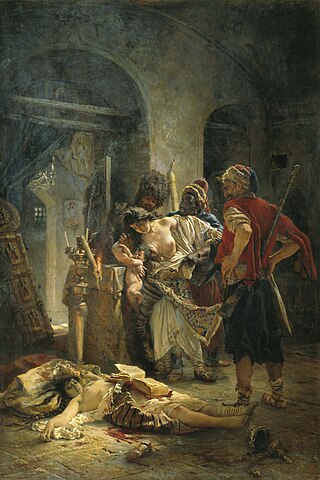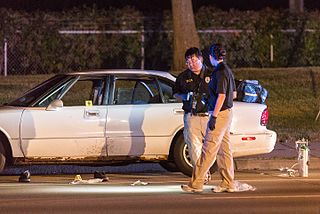
Theft is the act of taking another person's property or services without that person's permission or consent with the intent to deprive the rightful owner of it. The word theft is also used as a synonym or informal shorthand term for some crimes against property, such as larceny, robbery, embezzlement, extortion, blackmail, or receiving stolen property. In some jurisdictions, theft is considered to be synonymous with larceny, while in others, theft is defined more narrowly. A person who engages in theft is known as a thief.
Robbery is the crime of taking or attempting to take anything of value by force, threat of force, or by use of fear. According to common law, robbery is defined as taking the property of another, with the intent to permanently deprive the person of that property, by means of force or fear; that is, it is a larceny or theft accomplished by an assault. Precise definitions of the offence may vary between jurisdictions. Robbery is differentiated from other forms of theft by its inherently violent nature ; whereas many lesser forms of theft are punished as misdemeanors, robbery is always a felony in jurisdictions that distinguish between the two. Under English law, most forms of theft are triable either way, whereas robbery is triable only on indictment. The word "rob" came via French from Late Latin words of Germanic origin, from Common Germanic raub "theft".
Larceny is a crime involving the unlawful taking or theft of the personal property of another person or business. It was an offence under the common law of England and became an offence in jurisdictions which incorporated the common law of England into their own law, where in many cases it remains in force.
The following outline is provided as an overview of and topical guide to criminal justice:
Burglary, also called breaking and entering (B&E) and housebreaking, is the act of illegally entering a building or other areas without permission, typically with the intention of committing a further criminal offence. Usually that offence is theft, larceny, robbery, or murder, but most jurisdictions include others within the ambit of burglary. To commit burglary is to burgle, a term back-formed from the word burglar, or to burglarize.
Embezzlement is a term commonly used for a type of financial crime, usually involving theft of money from a business or employer. It often involves a trusted individual taking advantage of their position to steal funds or assets, most commonly over a period of time.
The Uniform Crime Reporting (UCR) program compiles official data on crime in the United States, published by the Federal Bureau of Investigation (FBI). UCR is "a nationwide, cooperative statistical effort of nearly 18,000 city, university and college, county, state, tribal, and federal law enforcement agencies voluntarily reporting data on crimes brought to their attention".
In criminal law, property is obtained by false pretenses when the acquisition results from the intentional misrepresentation of a past or existing fact.

Sacrilege is the violation or injurious treatment of a sacred object, site or person. This can take the form of irreverence to sacred persons, places, and things. When the sacrilegious offence is verbal, it is called blasphemy, and when physical, it is often called desecration. In a more general sense, any transgression against what is seen as the virtue of religion would be a sacrilege, and so is coming near a sacred site without permission.

The Theft Act 1968 is an act of the Parliament of the United Kingdom. It creates a number of offences against property in England and Wales.

The Penal Code of California forms the basis for the application of most criminal law, criminal procedure, penal institutions, and the execution of sentences, among other things, in the American state of California. It was originally enacted in 1872 as one of the original four California Codes, and has been substantially amended and revised since then.
Articles related to criminology and law enforcement.
A habitual offender, repeat offender, or career criminal is a person convicted of a crime who was previously convicted of other crimes. Various state and jurisdictions may have laws targeting habitual offenders, and specifically providing for enhanced or exemplary punishments or other sanctions. They are designed to counter criminal recidivism by physical incapacitation via imprisonment.
Civil recovery is the method in some legal systems employed to recover the proceeds of crime, instead of, or in addition to, criminal court proceedings.

National Incident-Based Reporting System (NIBRS) is an incident-based reporting system used by law enforcement agencies in the United States for collecting and reporting data on crimes. Local, state and federal agencies generate NIBRS data from their records management systems. Data is collected on every incident and arrest in the Group A offense category. These Group A offenses are 52 offenses grouped in 23 crime categories. Specific facts about these offenses are gathered and reported to NIBRS. In addition to the Group A offenses, 10 Group B offenses are reported with only the arrest information.
In England, Wales and Northern Ireland, taking without owner's consent (TWOC), also referred to as unauthorised taking of a motor vehicle (UTMV), describes any unauthorised use of a car or other conveyance that does not constitute theft. A similar offence, known as taking and driving away, exists in Scotland.
Burglary is a statutory offence in England and Wales.

Crime in Minnesota encompasses a wide range of unlawful activities that occur within the state, regulated by both state and federal laws. While crime rates in Minnesota are generally below the national average, certain areas and types of crime have garnered public attention.

The Larceny Act 1861 was an Act of the Parliament of the United Kingdom of Great Britain and Ireland. It consolidated provisions related to larceny and similar offences from a number of earlier statutes into a single Act. For the most part these provisions were, according to the draftsman of the Act, incorporated with little or no variation in their phraseology. It is one of a group of Acts sometimes referred to as the Criminal Law Consolidation Acts 1861. It was passed with the object of simplifying the law. It is essentially a revised version of an earlier consolidation Act, the Larceny Act 1827 (7 & 8 Geo. 4. c. 29), incorporating subsequent statutes.

Proposition 47, also known by its ballot title Criminal Sentences. Misdemeanor Penalties. Initiative Statute, was a referendum passed by voters in the state of California on November 4, 2014. The measure was also referred to by its supporters as the Safe Neighborhoods and Schools Act. It recategorized some nonviolent offenses as misdemeanors, rather than felonies, as they had previously been categorized.










